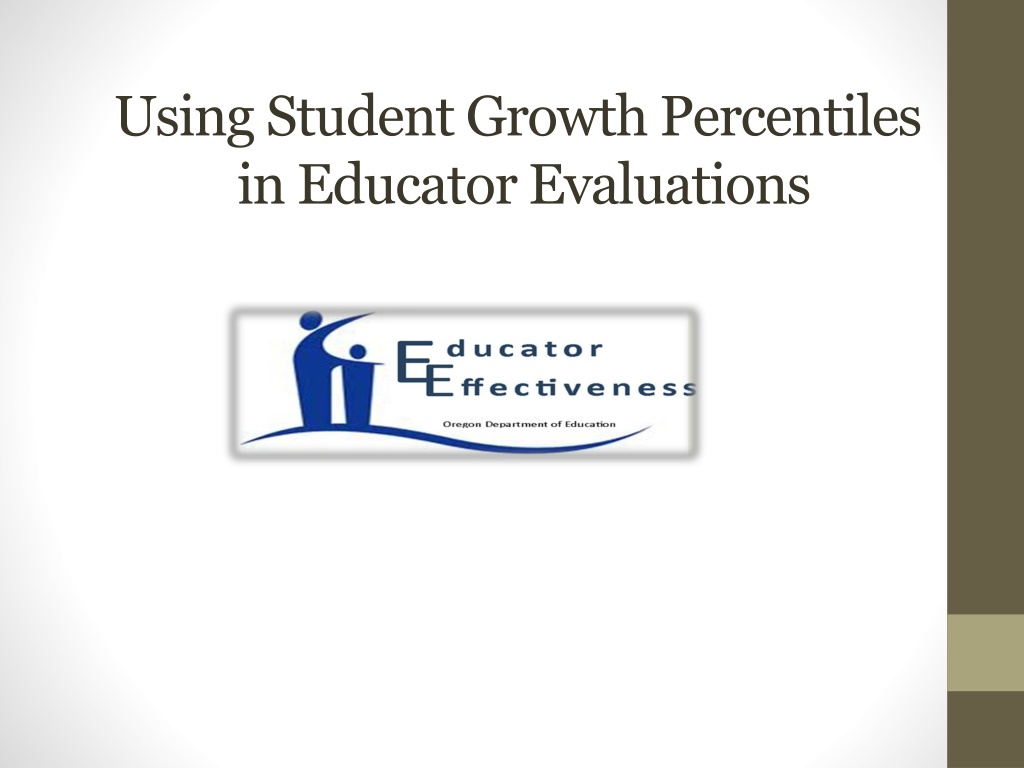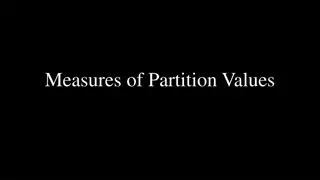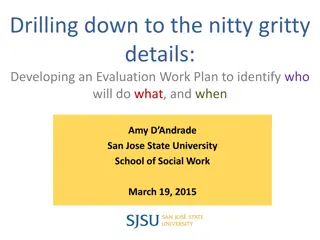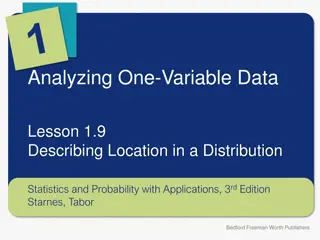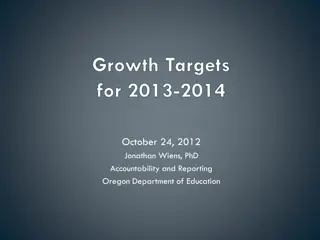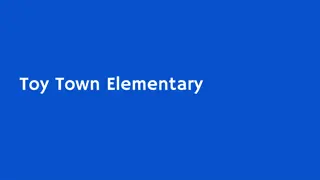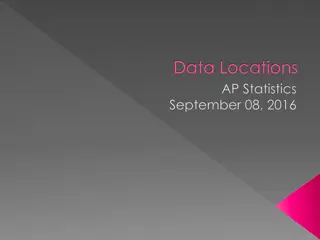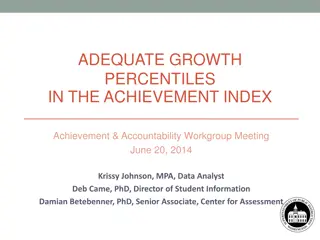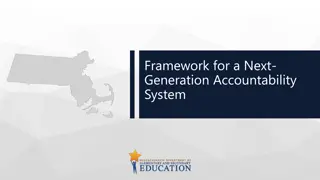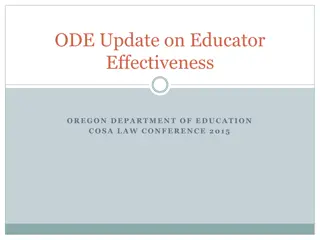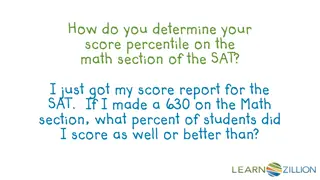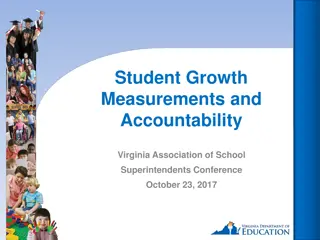Understanding Student Growth Percentiles in Education Evaluation
This collection of resources covers topics such as using student growth percentiles in educator evaluations, identifying median heights of students, establishing norms for collaborative environments, and discussing outcomes related to student growth percentiles in education reform. It touches on updates regarding waivers and requirements for using growth percentiles in assessing student learning and growth in schools.
Download Presentation

Please find below an Image/Link to download the presentation.
The content on the website is provided AS IS for your information and personal use only. It may not be sold, licensed, or shared on other websites without obtaining consent from the author. Download presentation by click this link. If you encounter any issues during the download, it is possible that the publisher has removed the file from their server.
E N D
Presentation Transcript
Using Student Growth Percentiles in Educator Evaluations
Warm Up The median is the middle number in a sequence of numbers On your table is a sheet of paper that lists the heights of students in a teacher s class Write the students heights in order from shortest to tallest Identify the median height and circle it
Norms Share your expertise Equity of voice Active listening Respect the current speaker no side conversations Safety to share different opinions and perspectives Respectful use of technology
Connector On an index card please complete the following sentence stem One of the most important learnings that I hope to take away today is
Give One, Get One! You will have 5 minutes to: Circulate around the room Introduce yourself to a colleague (name, position & district) Share the information on your card Start the process over again
Outcomes for Today To increase knowledge of Student Growth Percentiles (SGPs) and Median Student Growth Percentiles (MSGPs) Clarify the connection between SGPs and SLGs for the 2015-16 SY
Waiver Update On July 23, 2015,the USDOE approved Oregon s ESEA flexibility waiver renewal request for three years through the 2017- 2018 school year
In other words Oregon met the condition placed on our waiver the previous year to provide evidence of a statewide approach for how teachers and principals set their student learning and growth goals in tested grades and subjects to ensure rigor and consistency across the state
As a result Beginning in the 2015-16 school year, as a requirement of the ESEA waiver, all districts will begin using Student Growth Percentiles (SGPs) to meet the state assessment requirement for Student Learning and Growth (SLG) in grades 4-8 in English/Language arts (ELA) and math
Request to USED for 2015-16 ODE has requested a modification to the waiver Districts will determine MSGPs, but not incorporate them in educator summative evaluations for SY 2015-2016 Districts required to provide SGP training to staff ODE recommends that all educators set two goals that use Category 2 measures
Student Growth Percentiles (SGPs) Normative growth measure One year of growth Growth is relative to students with a similar score history
What do we mean by normative growth?
Percentiles 65% 35% 35th
Anthony 4th Grade 3rd Grade 2398 2262 Level 1 Level 2
Oregon Score Distribution 3rd Grade Reading Level 4 Level 3 Level 2 Level 1 2432 2367 2490 ELA/Literacy Scale Score Thresholds
Grade 4 Grade 3 Level 2 Level 3 Level 1 Level 4 4th Grade 2398 3rd Grade 2262
2398 - 2262 136 points
Level 2 Level 3 Level 1 Level 4 All 3rd grade test takers in Oregon with Anthony s Prior Score ~2262 19 Anthony
Lev el 2 Level 3 Level 1 Level 4 Anthony s Comparison Group Anthony s prior score ~2262 Anthony
4th Grade Score Distribution Level 2 Level 3 Level 1 Level 4 Middle score High score Anthony s Comparison Group Anthony s prior score ~2262
4th Grade Score Distribution 80% of students in Anthony s comparison group scored below him Level 2 Level 3 Level 1 Level 4 2398 Anthony s Comparison Group
4th Grade Score Distribution Level 2 Level 3 Level 1 SGP = 80 Level 4 Anthony s Comparison Group
Processing Time With the colleagues at your table: Talk about what you ve heard so far Identify a question your group still has about SGPs (Up Next: Determining Median SGPs)
Term Clarification A Student Growth Percentiles (SGP) measures growth for an individual student A Median Student Growth Percentile (MSGP) represents the exact middle of a group of students SGPs
Median Student Growth Percentiles Students in Mr. Waters class Student Sheryl Hector Robert Miranda Tre Anna Eric Anthony Amina SGP 3 22 36 38 51 54 71 80 93
Making a Determination of Student Growth The Median Student Growth Percentile (SGP) determines the educator s Category 1 SLG Rating Category 1 SLG Rating 1 2 3 4 65to 99 percentile Median SGP Criteria 1 to 34 percentile 35 to 49 percentile 50 to 64 percentile Interpretation Low growth Below average growth Above average growth High growth
X-Axis = SLG Rating SLG performance level based on two goals Two-year cycle select two of four goals Score SLG goals Get a rating between 1 and 4; Use X-Axis thresholds to determine SLG level: 4 = both goals 4s 3 = both goals 3s; one goal 3 & one goal 4; one goal 2 & one 4 2 = both goals 2s; one goal 2 & one 3; one goal 1 & one 3; one goal 4 & one 1 1= both goals 1s; one goal 1 & one 2 Mr. Waters MSGP was rated 3 Second SLG was rated 3 X-Axis Rating = Level 3 SLG Rating
Y-Axis = PP/PR Rating Mr. Waters Add up all component scores for total points possible; Divide by number of components in your rubric; Get a rating between 1 and 4; Use Y-Axis threshold to determine PP/PR level: 3.6 - 4.0 = 4 2.81-3.59 =3 1.99 2.8 = 2 * < 1.99 = 1 District rubric with 20 components Component ratings: 17 components were rated 3; and 3 were rated 2 = 57 points possible 57/20=2.85 2.85 = Level 3 PP/PR Rating *PP/PR Scoring Rule: If the educator scores two 1 s in any PP/PR component and his/her average score falls between 1.99-2.499, the educator s performance level cannot be rated above a 1.
Mr. Waters: Y-axis = 3 & X-axis = 3 Facilitative or Collegial * SLG Inquiry Collegial *SLG Inquiry Facilitative 4 Facilitative 4 LEVEL 4 3 3 or 4 Collegial 3 Consulting 2 Directed 1 Collegial or Consulting *SLG Inquiry 2 or 3 Consulting 2 Collegial 3 Consulting 2 Consulting or Directed * PP/PR Inquiry 1 or 2 Collegial 3 Collegial or Consulting * PP/PR Inquiry 2 or 3 Consulting * PP/PR Inquiry 2 LEVEL 4 Y-Axis: PP / PR LEVEL 3 LEVEL 2 Directed 1 LEVEL 1 *Inquiry Process LEVEL 1 LEVEL 2 LEVEL 3 X-Axis: SLG
Your Turn! Use the data packet provided to: Calculate Mr. Hendrick s Y-axis rating Determine Mr. Hendrick s median SGP Calculate Mr. Hendrick s X-axis rating Share Out
Facilitative or Collegial * SLG Inquiry Collegial *SLG Inquiry Facilitative 4 Facilitative 4 LEVEL 4 3 3 or 4 Collegial 3 Consulting 2 Directed 1 Collegial or Consulting *SLG Inquiry 2 or 3 Consulting 2 Collegial 3 Consulting 2 Consulting or Directed * PP/PR Inquiry 1 or 2 Collegial 3 Collegial or Consulting * PP/PR Inquiry 2 or 3 Consulting * PP/PR Inquiry 2 LEVEL 4 Y-Axis: PP / PR LEVEL 3 LEVEL 2 Directed 1 LEVEL 1 LEVEL 1 LEVEL 2 LEVEL 3 X-Axis: SLG *Inquiry Process
Timeline and Responsibilities 2015-16 SY ODE RESPONSIBILITIES DISTRICT RESPONSIBILITIES Provide districts state criteria for determining Median Student Growth Percentiles (see Table 3 on page 5 in this guidance). Select Option A or Option B to be used district-wide. Establish a process for determining the teacher of record. Fall 2015 Fall 2015 Provide districts with communications and guidance. Provide districts with professional development and technical support. Create class rosters and establish a roster verification process. Provide training in the district to educators, evaluators, and coordinating staff. 2015 2015- -16 School School Year Year 16 Administer Smarter Balanced Assessment Administer Smarter Balanced Assessment Educators verify class rosters. February February - - June June 2016 2016 Calculate Student Growth Percentiles for all students. Receive Student Growth Percentiles and Smarter Balanced results from ODE. Summer Summer 2016 2016 Send districts Student Growth Percentiles and Smarter Balanced achievement data in August. Provide guidance and support to districts. Determine the Median Student Growth Percentile ratings using the state criteria. Fall 2016 Fall 2016 Incorporate median Student Growth Percentile ratings into educator summative evaluations.
Impact on Evaluation Cycles Fall to Fall Summative conversation and evaluation takes place at the beginning of the following year Spring to Spring Preliminary summative evaluation conducted with the data available, verified in the fall
How do SGPs change the goal setting and scoring processes? Teachers and principals in grades 4- 8 in ELA and math All other educators
All Other Educators Minimum of 2 SLG goals each year Quality Review Checklist used for goal setting Goals can use either: Category 1 (statewide assessments) OR Category 2 (school or district-wide assessments) measures Goals scored using the statewide SLG Scoring Rubric Oregon Matrix used to identify summative scores Student Learning and Growth Guidance
Teachers and Principals in Grades 4 8 ELA and Math Minimum of 2 SLG goals each year Quality Review Checklist used for goal setting One goal must use Category 1 measure (Smarter) Method for scoring Category 1 goal depends on whether the district uses Option A or Option B Second goal can use either Category 1 or Category 2 measures Category 2 goals scored using the statewide SLG Scoring Rubric Oregon Matrix used to identify summative scores
Special Education/ Interventionists Only applies to teachers who are the primary providers of instruction Only the SGPs of students who take the statewide assessment (Smarter) in ELA or math are used in identifying an educator s MSGP Teachers for whom the majority of students take the Extended Assessment write a goal using the EA as the measure and score it using the statewide rubric
What do districts need to do? Select Option A or B Establish procedures Create rosters
Select Option A or Option B Option A Option B Educators are not required to set a Category 1 SLG goal. There is no required goal setting process for Category 1. Educators are required to set one Category 1 SLG goal using Smarter Balanced and rate their goal using the SLG scoring rubric. Educators are required to set one Category 2 SLG goal using the SLG goal template and rate their goal using the SLG scoring rubric Educators are required to set one Category 2 SLG goal using the SLG goal template and rate their goal using the SLG scoring rubric . Student Growth Percentiles are used exclusively to determine the Category 1 SLG rating. Educators SLG goal rating is then compared with their Median Student Growth Percentile rating to determine their final Category 1 SLG rating. Collaboration is key!
1. Districts determine which educators are required to use Median Student Growth Percentiles and create the educators class rosters for teachers and principals in grades 4-8, ELA/math. Fall 2. Educators set a Category 2 SLG goal following the SLG goal setting template. (They do not set a Category 1 SLG goal.) Spring 3. In May educators verify their class roster through a district-determined process. 4. Districts receive Student Growth Percentiles from ODE in August following the spring test administration. 5. Using the Student Growth Percentiles data from ODE, districts calculate the Median Student Growth Percentiles for the educator s class roster as follows: a. Rank the students scores in the class roster from highest to lowest. b. Locate the middle score (median) in the range to find the Median Student Growth Percentile. If the educator has an even number of students, average the two middle scores. c. Using the state criteria identify the corresponding Median Student Growth Percentile Category 1 SLG rating (1-4). Summer/ Fall 6. The educator and evaluator use the X-axis table to determine the educator s SLG performance level for the Oregon Matrix based on the Median Student Growth Percentile and Category 2 SLG goal ratings. OPTION A
1. Districts determine which educators are required to use median Student Growth Percentiles and create the educators class rosters for teachers and principals in grades 4-8, ELA/math. Fall 2. Educators set two goals: Category 1 SLG goal and Category 2 SLG goal following the SLG goal setting template. Spring 3. In May, educators verify their class roster through a district-determined process. 4. Districts receive Student Growth Percentiles from ODE in August following the spring test administration. 5. Using the Student Growth Percentiles data from ODE, districts calculate the Median Student Growth Percentiles for the educator s class roster as follows: Rank the students scores in the class roster from highest to lowest. Locate the middle score (median) in the range to find the Median Student Growth Percentile. If the educator has an even number of students, average the two middle scores. Using the state criteria identify the corresponding Median Student Growth Percentile Category 1 SLG rating (1-4). Summer/ Fall 6. Using the state assessment results, the educator and evaluator score the Category 1 SLG goal using the state SLG Goal Scoring Rubric. 7. The evaluator uses the decision table to compare the educator s Category 1 SLG goal rating with the Median Student Growth Percentile rating to determine the combined Category 1 SLG rating (X- and Y-axes intersect). 8. The educator and evaluator use the X-axis tableto determine the educator s SLG performance level for the Oregon Matrix based on the Median Student Growth Percentile and Category 2 SLG goal ratings. 9. If the ratings differ by more than two, use the inquiry process below to determine the final rating. OPTION B
FOCUSED COLLABORATION Learning Exercise Discuss with colleagues at your table how your district might go about making the decision as to which option the district will choose Remember Districts are advised to have a collaborative team of teachers, administrators, and association representatives work collaboratively to choose between Options A and B
Starting to Plan Before using Student Growth Percentiles, districts will need to establish procedures and a process for using Median Student Growth Percentiles district-wide. This process should be established Fall 2015
Establish Procedures Teacher of Record: which teachers and principals are responsible for content covered by Smarter Balanced assessments in grades 4-8 for ELA and math Roster creation and verification Provide rosters to teachers and principals in the fall for planning purposes Verify rosters in the spring for evaluation
Create rosters Determine who is on each roster Elementary: Every student in a class that takes Smarter in ELA or math Middle: All students within a particular course who take Smarter in either ELA or math Principals: All students in a particular grade who take Smarter in either ELA or math
Impact of Attendance Districts must use the state s definition of full academic year when including students on rosters consecutive enrollment in a school or district for more than one-half of the instructional days prior to the first school day in May
